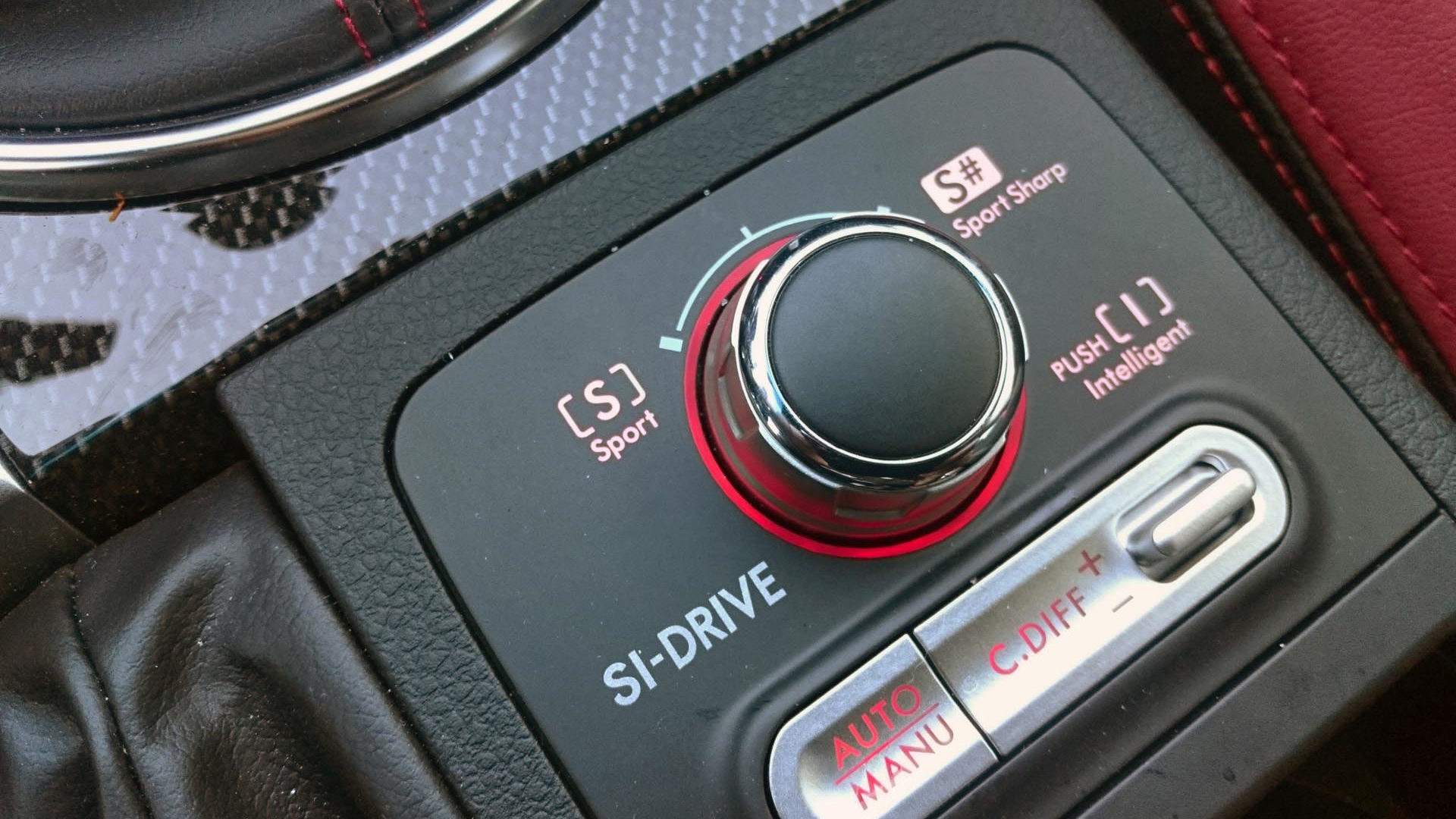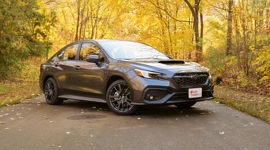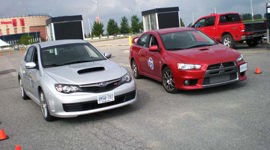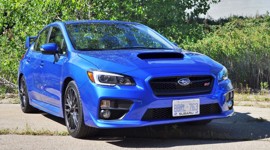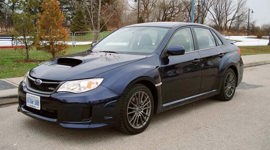 AutoTrader SCORE
AutoTrader SCORE
-
PERFORMANCE8/10
-
COMFORT7/10
-
INTERIOR7/10
-
FUEL ECONOMY7/10
-
EXTERIOR STYLING6/10
I didn’t mean to start a fight. Honest. I didn’t mean to cause disharmony in my team, to upset the rhythm our players had formed over the course of the season. I really didn’t think it would be that big a deal to them.
Such a simple question, yet it nearly caused a serious rift among the Toronto Buccaneers Rugby Club:
“So, who’s coming with me?”
“What are you driving this week?”
“WRX STI”
“Me”, “Me”, “Me”, “Me”, “Me”, “Me”, “Me”…
“No, ME!”, “No, ME!”, “No, ME!”, “No, ME!”
“Oh….”
Was it the giant rear spoiler? The iconic letterbox slot in the bonnet? The 18-inch wheels finished in gloss black with STI logos in the centres? The AWD-supported 305 hp/290 lb-ft of thrust? Maybe it was the ice-white paint job?
Maybe it wasn’t the car? I have lost weight recently… “Jacob, move! I need to take a photo of this for Facebook!”
Okay. It’s the car.
It’s understandable. The Subaru WRX STI is one of those “attainable” poster cars. The sort people have on their wall alongside the Lamborghini and the Ferrari but say “one day I will own that!”
Even today, six years since Subaru last competed in the World Rally Championship, this is the car most people think of when they think of the WRC. Subaru still races the STI in the Canadian Rally Championship and STIs are littered throughout the privateer ranks.
The STI is also a darling of tarmac racers and club racers (and of course, boy racers). It’s got a low entry price, significant AWD grip and solid power – not to mention a highly tunable little 2.5L turbocharged boxer engine. The STI is the best argument against my standard “rear-wheel drive is always better” position.
That 305 hp number, if we’re honest, is a little low these days. But it is shunting only 1,535 kg down the road in Sport package trim, (1,527 base and 1,567 in Sport Tech), and all of the power gets to the ground. The WRX STI hustles. It will launch off the line quicker than many a better-powered unit thanks to that brilliantly executed AWD system. It certainly impressed the lucky teammates who won the rumble to get into the passenger seats. One of them was so eager he even opted to squeeze into the middle back seat.
Memory Lane: Subaru’s Canadian Legacy
I wouldn’t advocate using this seat for adults usually, but he said he had no complaints back there. Amazing what a large rear spoiler allows people to put up with! The 340 L trunk swallowed all our bags and balls with a little Tetrising, and aside from the straddling in the middle seat, headroom and legroom is adequate. The sculpted outboard seats are nicely supportive.
This is important, because even with four large passengers on board you’ll want to throw the STI at every corner you come across. And it will reward you with a rapid turn-in and fantastic traction out of the corner. In the middle of the turn, however, stuff gets a bit untidy.
The steering has a strange habit of becoming loose in the middle of turns. This is particularly pronounced on long, high-speed turns (like freeway off-ramps) where the steering gets progressively lighter and springier as you wind in. By springier, I the steering wheel starts to ask less lock, even though the track hasn’t changed, so the wheel starts to move back towards the centre right at the moment you instinctively put on more lock.
This was disconcerting, but I’ve since quizzed Subaru about it – especially because this steering is hydraulic not electric. Their explanation was a bit of a “oh, der!” moment for me. The STI has torque vectoring, and Subaru believes that what I felt was the steering effort loosening as the torque vectoring began to take the corner stress on for me. It felt artificial – because in essence it is. I wish I’d queried them while I still had the car, maybe I could have tested it more. I wonder if they’ll let me rebook it. [They might, I won’t – Ed.]
In all other phases of cornering the STI is great. The steering feel is sharp when taking quick turns and even snatching gaps in traffic, and while the car has more body roll and pitch than I expected, it’s also extremely poised. There’s a fork in the road on my commute home that has a big rounded hump in the middle of it. The STI is one of the only cars that felt connected to the road the whole way around the bend and over the bump, most others feel like they lose contact or at least their footing in that moment.
Our tester was fitted with the $1,200 performance exhaust too, which gave the 2.5L a distinctive, alluring, and LOUD engine note – if you don’t like attention, don’t get this pipe. I do. And I got a lot too. STI aerodynamic upgrades ($1,900 worth of them) including a front splitter, rear diffuser and side skirts back up the attention-seeking sound with substantial curb appeal. No tacky aftermarket modifications necessary here.
Try as I might, I struggled to find a suitable gravel road to really put the WRX through its paces during my week in it. The sound of that exhaust resonating off the trees as you whip through the bush on the limit of adhesion is the stuff dreams are made of. Sadly for me, it’s still a dream. Instead I had to make do with the sound of the boxer engine bouncing off the concrete jungle of downtown Toronto, where the heavy clutch’s long, long pedal made a goose of me in traffic.
The lever gave me no such drama, the gates close, the throws short and the action snicky but confidence-inspiring.
The pedal placement is a little wide; I’d like them closer together but heel-and-toe downshifting is still easy to do – not to mention rewarding when the engine is on boil. Those brakes too, 326 mm rotors and Brembo four-piston front rotors (two-piston, 316 mm up back) grab firmly and fast, with a communicative pedal that allows you full control over stopping force. Setting the corner up is a lot easier when the brakes are this progressive and the STI feels planted even as the back gets light.
The seats offer a good platform for the driver with heavy bolstering and grippy suede inlays, while the steering wheel has exaggerated thumb rests and a good, thick rim to keep your hands where they need to be. If you don’t feel like a racecar driver in this thing, you never will. Even the gauges glow red with intent, and the buttons in the centre stack are all backlit red as well.
Long long time ago: Evolution of the Subaru STI
Even the little drive control puck in the console has an angry aura to it, which allows you to select Subaru’s SI mode. This drive mode selector affects the engine map, and a handy graph in the TFT screen between the gauges illustrates how the drive mode changes the map. Normal mode is a smooth, linear power curve. SI mode gives a steeper ramp and earlier peak power, SI# (sharp) mode gives you the steepest power ramp and the earliest peak power. Guess which mode we spent the entire week in?
I played around a little with the driver-controllable centre differential too. The idea is you can lock in a torque bias you enjoy most over six steps from RWD through FWD with manual mode. You can also ask the automatic torque split to lean rearward or forward as you prefer. When I tried it on max rear bias it felt a little wonky at low speeds, so I put it back to automatic.
Subaru deserves bulk credit for an all-wheel-drive system that allows you that flexibility, it’s something I’ve longed for and wanted in other AWD cars and it’s surprising that I found it here in the Subaru when more expensive AWD sports cars don’t have anything similar.
Which brings me to the best thing about Subaru’s flagship: There are few cars this affordable and attainable which offer not only the driving experience, but the admiration of the passing public. The Subaru WRX STI attains a level of lust and recognition that a $40,000 car rarely does.
It is the epitome of the Boy Racer, in the best possible way.
| Warranty: 3 years/60,000 km; 5 years/100,000 km powertrain; 5 years/unlimited distance corrosion perforation; 3 years/unlimited distance roadside assistance Competitors: |
| Model Tested | 2016 Subaru WRX STI Sport Package |
|---|---|
| Base Price | $40,795 |
| A/C Tax | |
| Destination Fee | $1,650 |
| Price as Tested | $45,645 |
|
Optional Equipment
STI front underspoiler - $440, rear underspoiler - $520, rear quarter underspoiler - $370, side underspoiler - $570, STI Performance Exhaust - $1,200
|
|






















